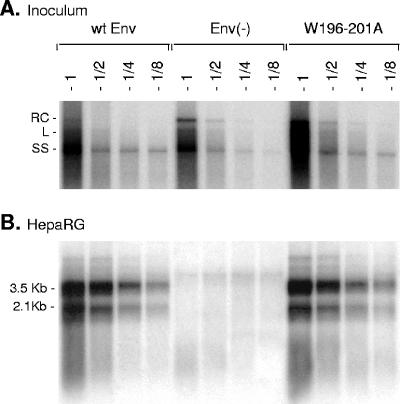FIG. 7.
Effects of CYL-II envelope protein mutations on infectivity of HBV virions. (A) Culture medium from cells transfected with pCIHBenv(−) and 1 μg of pT7HB2.7 (wt Env), an empty plasmid, Env(−), or W196-201A mutant plasmid, collected at days 3, 6, 9, and 11 posttransfection (Sup), were pooled and subjected to a 20× concentration by precipitation with PEG 8000. One hundred microliters of undiluted (1) or a two- (1/2), four- (1/4), or eightfold (1/8) dilution of each inoculum was examined for the presence of HBV DNA. HBV DNA signals in the inoculum derived from cells transfected in the absence of envelope protein coding plasmid [Env(−)] are from extracellular nonenveloped nucleocapsids, whereas signals from wt Env and W196-201A samples are from both naked nucleocapsids and virions. (B) HepaRG cells (3.3 × 105 cells) were exposed to 2 ml of inoculum for 16 h in the presence of 5% PEG 8000. HepaRG cells were harvested at day 12 postinoculation, and mRNA was purified and tested for the presence of newly synthesized HBV mRNA by Northern blot hybridization using a negative-strand-specific, 32P-labeled RNA probe. RC, relax circular; L, linear; SS, single strand. The sizes in kilobases of HBV mRNAs are indicated.

